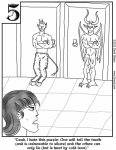I'll agree that 4e's attempt to differentiate them eventually fell by the wayside after the first monster manual, but I thought it was a good idea. In the
Pathfinder rules, though, demons are just a variation on devils. As the article explains it, this is what I consider the best difference:
"Asmodeus rules Hell with despotic pride, and all devils conform to his strict hierarchy or face destruction. Within the chain of command, lesser devils use whatever power they have to mimic their ultimate leader. Devils work to gain influence in the cosmos, especially among mortals in the world. They eagerly respond to any summons and readily form cleverly worded pacts. They plan and build to meet their needs, making and using all sorts of devices, tools, and weapons. A devil might be supernaturally potent, and it might possess incredible magic items, but its greatest assets are its shrewdly calculating mind and eternal patience. Devils want to impose a sort of order -- specifically theirs -- on the cosmos."
"Most demons are savage and fearless engines of annihilation. Although sometimes driven by unspeakable yearning or by horrifying demon lords to gather in groups, demons have no real organization and no singular aim. Demons don’t negotiate, and they build nothing lasting. Most use tooth and claw rather than artificial weapons. They care little or nothing for souls. Even the mightiest demon lords manipulate other demons by using threats, direct violence, or the promise of more destruction through affiliation. Although the lords of the Abyss that veteran D&D players know and love to hate still exist, no monolithic hierarchy supports any demon’s influence. Although a demon might want to destroy another creature and take that creature’s power, success only results in the winning demon using and squandering what it has seized. Demons have no regard for the responsibilities of authority, and they care little for keeping what they acquire. They’re forces of unmaking, and a universe under them would reflect the horror that is the Abyss, if that universe survived at all."
Demons are personifications of
chaotic evil (read: an entire race of
The Joker). In particular, babau, coloxus, glabrezu, incubus, kalavakus, marilith, nalfeshnee, quasit, succubus, and vrolikai are the most lawful demons. They can pull off complex schemes that require patience and restraint. As it stands, we have five lawful evil fiend races (asura, devil, kyton, oni, rakshasa), three chaotic evil fiend races (demodands, demons, qlippoth) and two neutral evil fiend races (daemons, divs). These are their MOs:
- Asura: destroy the work of the gods
- Devil: conquer the world
- Kyton: torture victims and themselves
- Oni: dominate and consume material pleasures
- Rakshasa: same as Oni
- Demodand: same as Asura
- Demon: generally wreak havoc
- Qlippoth: extinction of all life
- Daemons: same as Qlippoth
- Divs: orchestrate suffering
Most of those MOs work out to the same result in practice: murderizing everything. I think that's a good enough justification for making a race of neutral evil fiends that personify vice as opposed to saying only demons are viceful (in addition to oni and rakshasa).



